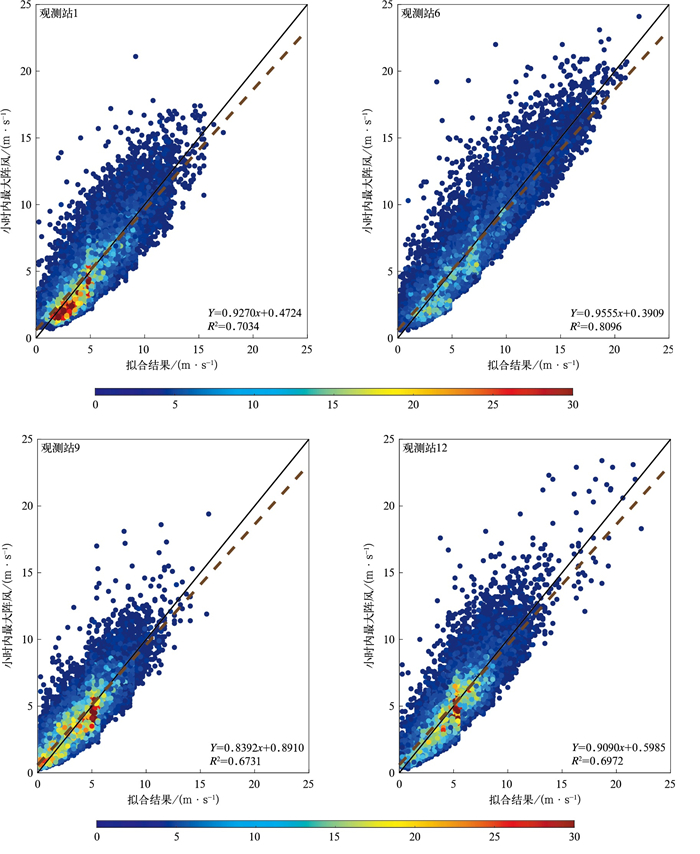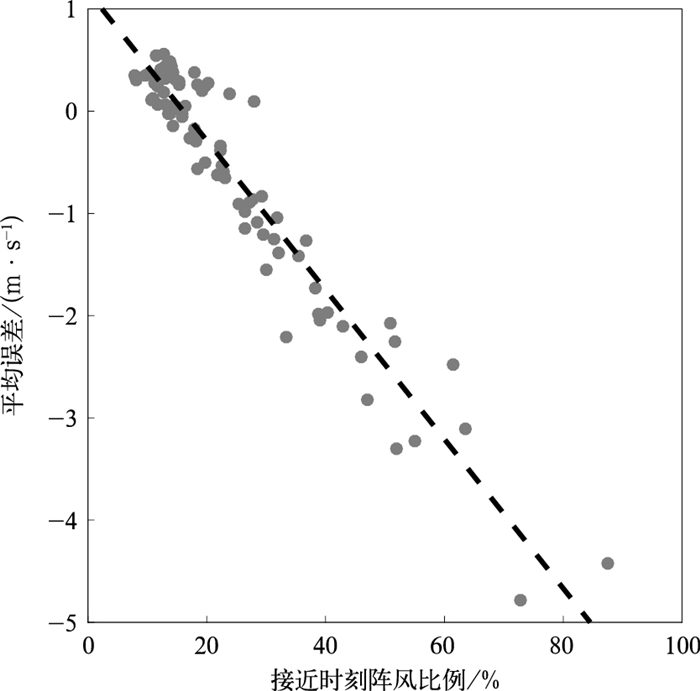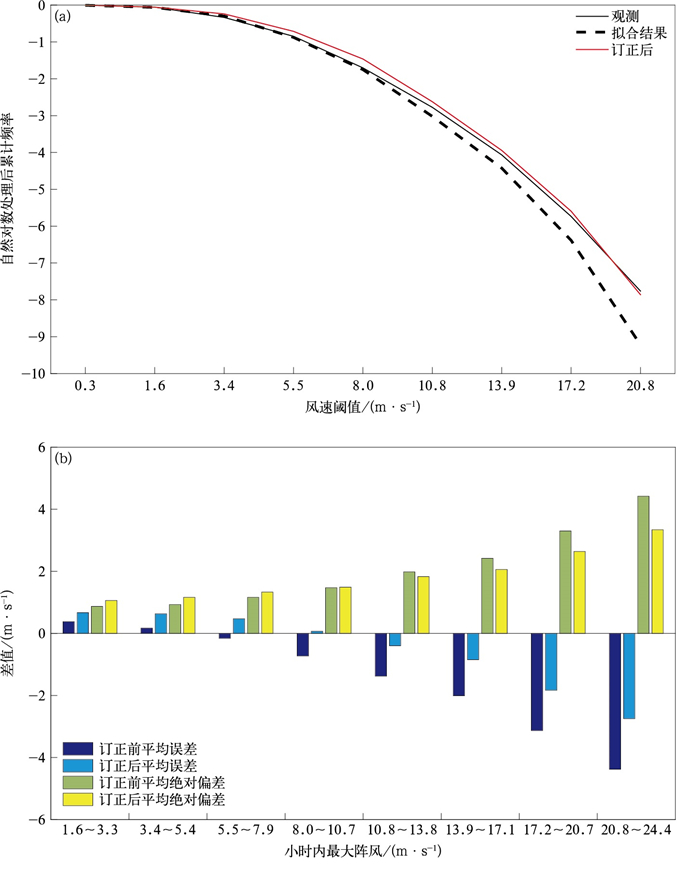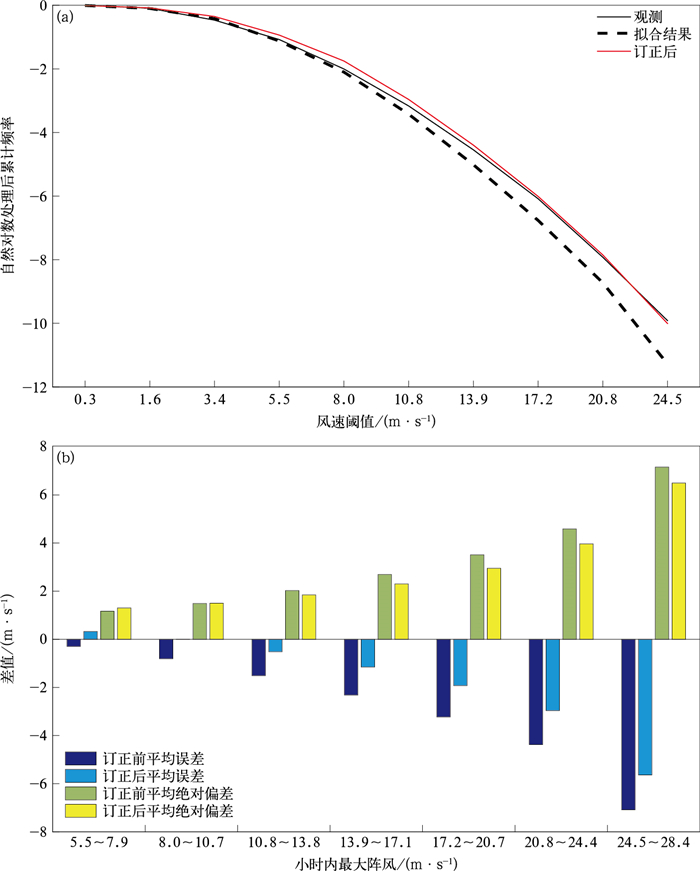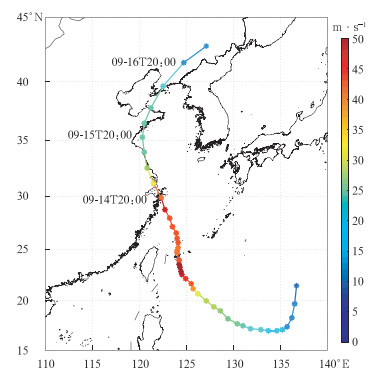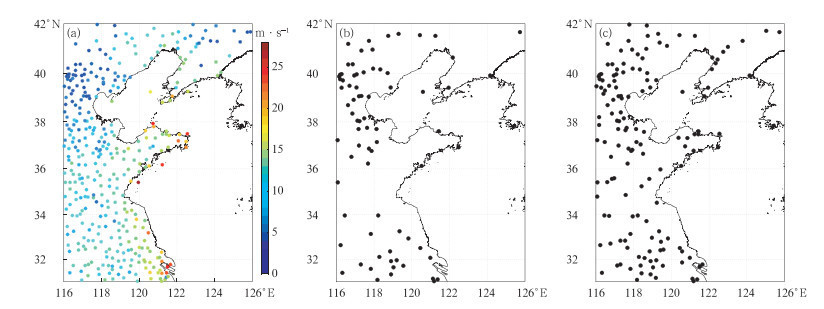Correction of Gust Estimation in the Yellow and Bohai Seas and Adjacent Areas
-
摘要: 为定量化下垫面等局地性因素对阵风拟合效果的影响, 利用2021年1月—2022年12月风速观测数据, 分析阵风系数方法在黄渤海及其邻近地区不同观测站拟合能力差异的原因, 并基于差异系数及频率匹配构建阵风估测改进(gust estimation correction, GECO)方法, 对阵风系数方法拟合结果进行订正。结果表明:阵风系数方法的拟合结果随风速增加更倾向于整点观测时刻阵风, 使用小时内最大阵风与整点观测时刻阵风计算得到的差异系数可以定量表征观测站局地特性对阵风系数拟合结果的影响。对差异系数大的观测站, 阵风系数方法对其强阵风拟合结果的负偏差也较大, 需对其进行更大幅度订正。基于12个基准观测站构建的GECO方法同样适用于黄渤海及其邻近地区的364个观测站。对于风速为12 m·s-1及以上和16 m·s-1及以上的阵风, 经GECO方法订正后的均方根误差较阵风系数方法分别减少12.3%和11.5%。对台风梅花(2212)的检验显示, GECO方法能够有效提升大级别阵风的估测能力, 可为阵风客观预报方法改进提供参考。Abstract: Due to the influence of local factors such as underlying surface, the fitting performance of the gust factor method can vary among different observation stations in the Yellow and Bohai Seas and adjacent areas. Therefore, based on observations from January 2021 to December 2022, causes for different performances are analyzed, and a gust estimation correction (GECO) method is proposed based on the coefficient of difference and frequency matching to correct fitting results of the gust factor method. It's concluded that, as the gust wind speed increases, the fitting results tend to be biased towards the gust at the whole observation time rather than the maximum gust within the hour. The difference coefficient calculated from the maximum gust within the hour and the gust at the whole hour observation time can quantitatively characterize the influence of local characteristics of the observation station on fitting results. For stations with large difference coefficients, the gust factor method has a larger negative bias in fitting the strong gusts, so it needs to be corrected to a greater extent. Conversely, for stations with small differences, the gust factor method has a smaller negative bias in fitting the strong gusts, so it only needs to be corrected to a smaller extent. GECO method constructed based on statistical results of 12 benchmark observation stations can also be applied to 364 stations in the Yellow and Bohai Seas and adjacent areas, demonstrating the feasibility of quantitatively characterizing the influence of local factors such as underlying surface on fitting results of gusts, as well as the stability of GECO method. In the comparative test of fitting errors for 364 stations in the Yellow and Bohai Seas and adjacent areas, after correction by GECO method, the root mean square error of gusts above 12 m·s-1 and 16 m·s-1 is reduced by 12.3% and 11.5%, respectively, compared to the gust factor method. Although GECO method may slightly increase the fitting error of weak gusts, it can significantly improve the fitting performance of strong gusts. In the verification during the impact of Typhoon Muifa from 14 September to 16 September in 2022, the fitting performance of strong gusts is also significantly improved after correction by GECO method. The improvement of fitting performance is the basis for improving forecasting skill. Combining GECO method with other objective gust forecasting methods can further enhance the forecasting service capability of gusts.
-
图 9 2022年9月14日20:00—16日20:00台风梅花(2022)影响期间小时内最大阵风极大值(a)、阵风系数方法(b)及经GECO方法订正后(c)拟合结果为正偏差的观测站分布
Fig. 9 Maximum hourly gust during the impact of Typhoon Muifa from 2000 BT 14 Sep to 2000 BT 16 Sep in 2022(a), the distribution of stations with positive bias in fitting results of gusts by applying the gust factor method(b) and GECO method(c)
表 1 基准观测站信息
Table 1 Benchmark observation station information
序号 区站号 位置 海拔/m 1 54337 41.1°N,121.1°E 65 2 54497 40.1°N,124.3°E 13 3 54511 39.8°N,116.5°E 33 4 54539 39.4°N,118.9°E 8 5 54662 38.9°N,121.6°E 90 6 54727 36.7°N,117.6°E 122 7 54857 36.1°N,120.3°E 75 8 54778 37.2°N,122.5°E 61 9 58027 34.3°N,117.2°E 42 10 58150 33.8°N,120.3°E 1 11 58238 31.9°N,118.9°E 36 12 58362 31.4°N,121.5°E 6 表 2 2021年1月—2022年12月订正前后12个基准观测站对于风速为12 m·s-1及以上阵风拟合误差对比
Table 2 Comparison of fitting errors before and after correction for 12 benchmark observation stations with gusts no less than 12 m·s-1 from Jan 2021 to Dec 2022
序号 订正前平均误差/(m·s-1) 订正后平均误差/(m·s-1) 均方根误差减少率/% 1 -2.69 -1.40 19.14 2 -1.76 -0.66 12.72 3 -2.69 -1.43 16.44 4 -2.42 -1.24 17.33 5 -2.01 -0.70 12.78 6 -1.25 0.40 6.01 7 -1.45 -0.32 7.27 8 -1.97 -0.78 13.27 9 -3.56 -2.36 14.69 10 -1.80 -0.84 12.32 11 -2.90 -1.90 14.78 12 -3.00 -1.82 14.18 表 3 2021年1月—2022年12月阵风系数方法对陆地及浮标观测站拟合误差对比
Table 3 Comparison of fitting errors of gust factor method for land and buoy observation stations from Jan 2021 to Dec 2022
统计量 风速范围/(m·s-1) 10.8~13.8 13.9~17.1 17.2~20.7 陆地样本量 48706 10374 1483 浮标样本量 4433 1866 544 陆地拟合误差标准差/(m·s-1) 2.705 3.516 4.979 浮标拟合误差标准差/(m·s-1) 1.830 2.082 2.236 陆地拟合误差平均值/(m·s-1) -2.47 -3.66 -5.54 浮标拟合误差平均值/(m·s-1) -0.60 -0.83 -1.21 -
[1] 董双林.中国的阵风极值及其统计研究.气象学报, 2001, 59(3):327-333. https://www.cnki.com.cn/Article/CJFDTOTAL-QXXB200103006.htmDong S L. Gust extremes in China and its statistical study. Acta Meteor Sinica, 2001, 59(3): 327-333. https://www.cnki.com.cn/Article/CJFDTOTAL-QXXB200103006.htm [2] Masters F J, Vickery P J, Bacon P, et al. Toward objective, standardized intensity estimates from surface wind speed observations. Bull Amer Meteor Soc, 2010, 91(12): 1665-1682. doi: 10.1175/2010BAMS2942.1 [3] Kahl J D W. Forecasting peak wind gusts using meteorologically stratified gust factors and MOS guidance. Wea Forecasting, 2020, 35(3): 1129-1143. doi: 10.1175/WAF-D-20-0045.1 [4] 全继萍, 李青春, 仲跻芹, 等. "CMA北京模式"中三种不同阵风诊断方案在北京地区大风预报中的评估. 气象学报, 2022, 80(1): 108-123. https://www.cnki.com.cn/Article/CJFDTOTAL-QXXB202201008.htmQuan J P, Li Q C, Zhong J Q, et al. Evaluation of three different gust diagnostic schemes in the CMA-BJ for gale forecasting over Beijing. Acta Meteor Sinica, 2022, 80(1): 108-123. https://www.cnki.com.cn/Article/CJFDTOTAL-QXXB202201008.htm [5] Lang V A, Turner T J, Selbig B R, et al. Predicting peak wind gusts during specific weather types with the meteorologically stratified gust factor model. Wea Forecasting, 2022, 37(8): 1435-1446. doi: 10.1175/WAF-D-21-0201.1 [6] Zhang X Y, Proppe C. Risk assessment of road vehicles under wind gust excitation. J Comput Nonlinear Dyn, 2020, 15(10). DOI: 10.1115/1.4047638. [7] Kahl J D W, Selbig B R, Harris A R. Meteorologically stratified gust factors for forecasting peak wind gusts across the United States. American Meteor Society, 2021, 102: 1665-1671. doi: 10.1175/BAMS-D-21-0013.1 [8] European Center for Medium-Range Weather Forecasts(ECMWF). IFS Documentation CY47R3-Part Ⅳ: Physical Processes. 2021. [9] 穆穆, 陈博宇, 周菲凡, 等. 气象预报的方法与不确定性. 气象, 2011, 37(1): 1-13. https://www.cnki.com.cn/Article/CJFDTOTAL-QXXX201101002.htmMu M, Chen B Y, Zhou F F, et al. Methods and uncertainties of meteorological forecast. Meteor Mon, 2011, 37(1): 1-13. https://www.cnki.com.cn/Article/CJFDTOTAL-QXXX201101002.htm [10] 韩念霏, 杨璐, 陈明轩, 等. 京津冀站点风温湿要素的机器学习订正方法. 应用气象学报, 2022, 33(4): 489-500. doi: 10.11898/1001-7313.20220409Han N F, Yang L, Chen M X, et al. Machine learning correction of wind, temperature and humidity elements in Beijing-Tianjin-Hebei Region. J Appl Meteor Sci, 2022, 33(4): 489-500. doi: 10.11898/1001-7313.20220409 [11] 胡莹莹, 庞林, 王启光. 基于深度学习的7~15 d温度格点预报偏差订正. 应用气象学报, 2023, 34(4): 426-437. doi: 10.11898/1001-7313.20230404Hu Y Y, Pang L, Wang Q G. Application of deep learning bias correction method to temperature grid forecast of 7-15 days. J Appl Meteor Sci, 2023, 34(4): 426-437. doi: 10.11898/1001-7313.20230404 [12] 胡海川, 周军. 集合预报在渤海极大风预报中的应用. 气象, 2019, 45(12): 1747-1755. https://www.cnki.com.cn/Article/CJFDTOTAL-QXXX201912012.htmHu H C, Zhou J. Application of ensemble extreme wind forecast in Bohai Sea. Meteor Mon, 2019, 45(12): 1747-1755. https://www.cnki.com.cn/Article/CJFDTOTAL-QXXX201912012.htm [13] Harris A R, Kahl J D W. Gust factors: Meteorologically stratified climatology, data artifacts, and utility in forecasting peak gusts. J Appl Meteor Climatol, 2017, 56(12): 3151-3166. doi: 10.1175/JAMC-D-17-0133.1 [14] Schulz B, Lerch S. Machine learning methods for postprocessing ensemble forecasts of wind gusts: A systematic comparison. Mon Wea Rev, 2022, 150(1): 235-257. doi: 10.1175/MWR-D-21-0150.1 [15] 朱智慧, 郑运霞, 过霁冰. 上海沿海站点极大风速预报方程的细化和完善. 海洋预报, 2022, 39(1): 32-38. https://www.cnki.com.cn/Article/CJFDTOTAL-HYYB202201004.htmZhu Z H, Zheng Y X, Guo J B. Refinement and improvement of the maximum wind speed prediction equation for Shanghai coastal stations. Mar Forecasts, 2022, 39(1): 32-38. https://www.cnki.com.cn/Article/CJFDTOTAL-HYYB202201004.htm [16] 胡海川, 刘珺, 林建. 基于预报方程的我国近海阵风预报. 气象, 2022, 48(3): 334-344. https://www.cnki.com.cn/Article/CJFDTOTAL-QXXX202203007.htmHu H C, Liu J, Lin J. Application of prediction equation to gust forecasting for Chinese offshore areas. Meteor Mon, 2022, 48(3): 334-344. https://www.cnki.com.cn/Article/CJFDTOTAL-QXXX202203007.htm [17] Shu Z R, Li Q S, He Y C, et al. Gust factors for tropical cyclone, monsoon and thunderstorm winds. J Wind Eng Ind Aerodyn, 2015, 142: 1-14. doi: 10.1016/j.jweia.2015.02.003 [18] 周福, 蒋璐璐, 涂小萍, 等. 浙江省几种灾害性大风近地面阵风系数特征. 应用气象学报, 2017, 28(1): 119-128. doi: 10.11898/1001-7313.20170111Zhou F, Jiang L L, Tu X P, et al. Near-surface gust factor characteristics in several disastrous winds over Zhejiang Province. J Appl Meteor Sci, 2017, 28(1): 119-128. doi: 10.11898/1001-7313.20170111 [19] 杨璐, 王晓丽, 宋林烨, 等. 基于阵风系数模型的百米级阵风客观预报算法研究. 气象学报, 2023, 81(1): 94-109. https://www.cnki.com.cn/Article/CJFDTOTAL-QXXB202301006.htmYang L, Wang X L, Song L Y, et al. An algorithm for objective forecasting of gust winds at 100 m horizontal resolution based on a gust coefficient model. Acta Meteor Sinica, 2023, 81(1): 94-109. https://www.cnki.com.cn/Article/CJFDTOTAL-QXXB202301006.htm [20] 陈燕, 张宁. 江苏沿海近地层风阵性及台风对其影响. 应用气象学报, 2019, 30(2): 177-190. doi: 10.11898/1001-7313.20190205Chen Y, Zhang N. The wind turbulence of the near-surface layer of Jiangsu coastal area and its response to typhoon. J Appl Meteor Sci, 2019, 30(2): 177-190. doi: 10.11898/1001-7313.20190205 [21] Yu B, Chowdhury G A. Gust factors and turbulence intensities for the tropical cyclone environment. J Appl Meteor Climatol, 2009, 48(3): 534-552. [22] 胡波. 浙江沿海台风阵风系数的影响因子分析. 热带气象学报, 2017, 33(6): 841-849. https://www.cnki.com.cn/Article/CJFDTOTAL-RDQX201706005.htmHu B. Analysis of gust factor associated with typhoons on Zhejiang coast. J Trop Meteor, 2017, 33(6): 841-849. https://www.cnki.com.cn/Article/CJFDTOTAL-RDQX201706005.htm [23] Letson F, Pryor S C, Barthelmie R J, et al. Observed gust wind speeds in the coterminous United States, and their relationship to local and regional drivers. J Wind Eng Ind Aerodyn, 2018, 173: 199-209. [24] Zhu Y J, Luo Y. Precipitation calibration based on the frequency-matching method. Wea Forecasting, 2015, 30(5): 1109-1124. [25] 宇婧婧, 沈艳, 潘旸, 等. 概率密度匹配法对中国区域卫星降水资料的改进. 应用气象学报, 2013, 24(5): 544-553. http://qikan.camscma.cn/article/id/20130504Yu J J, Shen Y, Pan Y, et al. Improvement of satellite-based precipitation estimates over China based on probability density function matching method. J Appl Meteor Sci, 2013, 24(5): 544-553. http://qikan.camscma.cn/article/id/20130504 [26] 何立富, 齐道日娜, 余文. 引发东北极端暴雪的黄渤海气旋爆发性发展机制. 应用气象学报, 2022, 33(4): 385-399. doi: 10.11898/1001-7313.20220401He L F, Chyi D, Yu W. Development mechanisms of the Yellow Sea and Bohai Sea cyclone causing extreme snowstorm in Northeast China. J Appl Meteor Sci, 2022, 33(4): 385-399. doi: 10.11898/1001-7313.20220401 [27] 刘涛, 端义宏, 冯佳宁, 等. 台风利奇马(1909)双眼墙特征及长时间维持机制. 应用气象学报, 2021, 32(3): 289-301. doi: 10.11898/1001-7313.20210303Liu T, Duan Y H, Feng J N, et al. Characteristics and mechanisms of long-lived concentric eyewalls in Typhoon Lekima in 2019. J Appl Meteor Sci, 2021, 32(3): 289-301. doi: 10.11898/1001-7313.20210303 [28] 梁军, 张胜军, 刘晓初, 等. 辽东半岛和山东半岛地形对黄、渤海大风影响的数值模拟试验. 热带气象学报, 2015, 31(3): 374-384. https://www.cnki.com.cn/Article/CJFDTOTAL-RDQX201503009.htmLiang J, Zhang S J, Liu X C, et al. Numerical simulation of high wind events over the Yellow Sea and the Bohai Sea considering topographic effects of Liaodong Peninsula and Shandong Peninsula. J Trop Meteor, 2015, 31(3): 374-384. https://www.cnki.com.cn/Article/CJFDTOTAL-RDQX201503009.htm [29] Brasseur O. Development and application of a physical approach to estimating wind gusts. Mon Wea Rev, 2001, 129(1): 5-25. [30] Minola L, Zhang F, Azorin-Molina C, et al. Near-surface mean and gust wind speeds in ERA5 across Sweden: Towards an improved gust parametrization. Climate Dyn, 2020, 55(3): 887-907. [31] 邢彩盈, 吴胜安, 朱晶晶. 基于不同资料的影响南海热带气旋环流背景对比. 应用气象学报, 2023, 34(2): 179-192. doi: 10.11898/1001-7313.20230205Xing C Y, Wu S A, Zhu J J. Comparison on the circulation background of tropical cyclone affecting the South China Sea based upon different reanalysis datasets. J Appl Meteor Sci, 2023, 34(2): 179-192. doi: 10.11898/1001-7313.20230205 [32] 蒋溢, 伍书平, 胡昆, 等. 基于Lasso和构造性覆盖算法的不均衡数据分类方法. 计算机应用, 2023, 43(4): 1086-1093. https://www.cnki.com.cn/Article/CJFDTOTAL-JSJY202304013.htmJiang Y, Wu S P, Hu K, et al. Imbalanced data classification method based on Lasso and constructive covering algorithm. J Comput Appl, 2023, 43(4): 1086-1093. https://www.cnki.com.cn/Article/CJFDTOTAL-JSJY202304013.htm [33] 刘颖, 杨轲. 基于深度集成学习的类极度不均衡数据信用欺诈检测算法. 计算机研究与发展, 2021, 58(3): 539-547. https://www.cnki.com.cn/Article/CJFDTOTAL-JFYZ202103009.htmLiu Y, Yang K. Credit fraud detection for extremely imbalanced data based on ensembled deep learning. J Comput Res Dev, 2021, 58(3): 539-547. https://www.cnki.com.cn/Article/CJFDTOTAL-JFYZ202103009.htm [34] 王志春, 植石群, 丁凌云. 强台风纳沙(1117)近地层风特性观测分析. 应用气象学报, 2013, 24(5): 595-605. http://qikan.camscma.cn/article/id/20130509Wang Z C, Zhi S Q, Ding L Y. Observation and analysis on Giongzhou Strait gales of severe Typhoon Neasat(2011). J Appl Meteor Sci, 2013, 24(5): 595-605. http://qikan.camscma.cn/article/id/20130509 [35] 胡海川, 赵伟, 董林. 概率密度匹配方法在我国近海海面10 m风速预报中的应用. 热带气象学报, 2021, 37(1): 91-101. https://www.cnki.com.cn/Article/CJFDTOTAL-RDQX202101009.htmHu H C, Zhao W, Dong L. Application of probability density function matching in the offshore 10 m wind speed forecasting in China. J Trop Meteor, 2021, 37(1): 91-101. https://www.cnki.com.cn/Article/CJFDTOTAL-RDQX202101009.htm [36] 智协飞, 吕游. 基于频率匹配法的中国降水多模式预报订正研究. 大气科学学报, 2019, 42(6): 814-823. https://www.cnki.com.cn/Article/CJFDTOTAL-NJQX201906002.htmZhi X F, Lyu Y. Calibration of the multimodel precipitation forecasts in China using the frequency matching method. Trans Atmos Sci, 2019, 42(6): 814-823. https://www.cnki.com.cn/Article/CJFDTOTAL-NJQX201906002.htm [37] 智协飞, 赵忱. 基于集合成员订正的强降水多模式集成预报. 应用气象学报, 2020, 31(3): 303-314. doi: 10.11898/1001-7313.20200305Zhi X F, Zhao C. Heavy precipitation forecasts based on multi-model ensemble members. J Appl Meteor Sci, 2020, 31(3): 303-314. doi: 10.11898/1001-7313.20200305 [38] 张进, 孙健, 沈学顺, 等. CMA-GFS V4.0模式关键技术研发和业务化. 应用气象学报, 2023, 34(5): 513-526. doi: 10.11898/1001-7313.20230501Zhang J, Sun J, Shen X S, et al. Key model technologies of CMA-GFS V4.0 and application to operational forecast. J Appl Meteor Sci, 2023, 34(5): 513-526. doi: 10.11898/1001-7313.20230501 -


 设为首页
设为首页 加入收藏
加入收藏



 下载:
下载:
